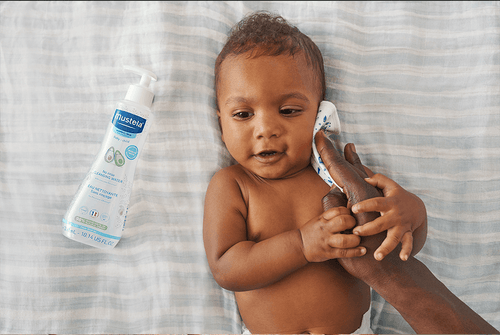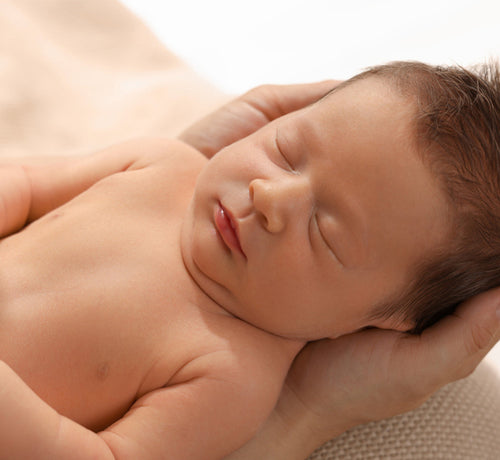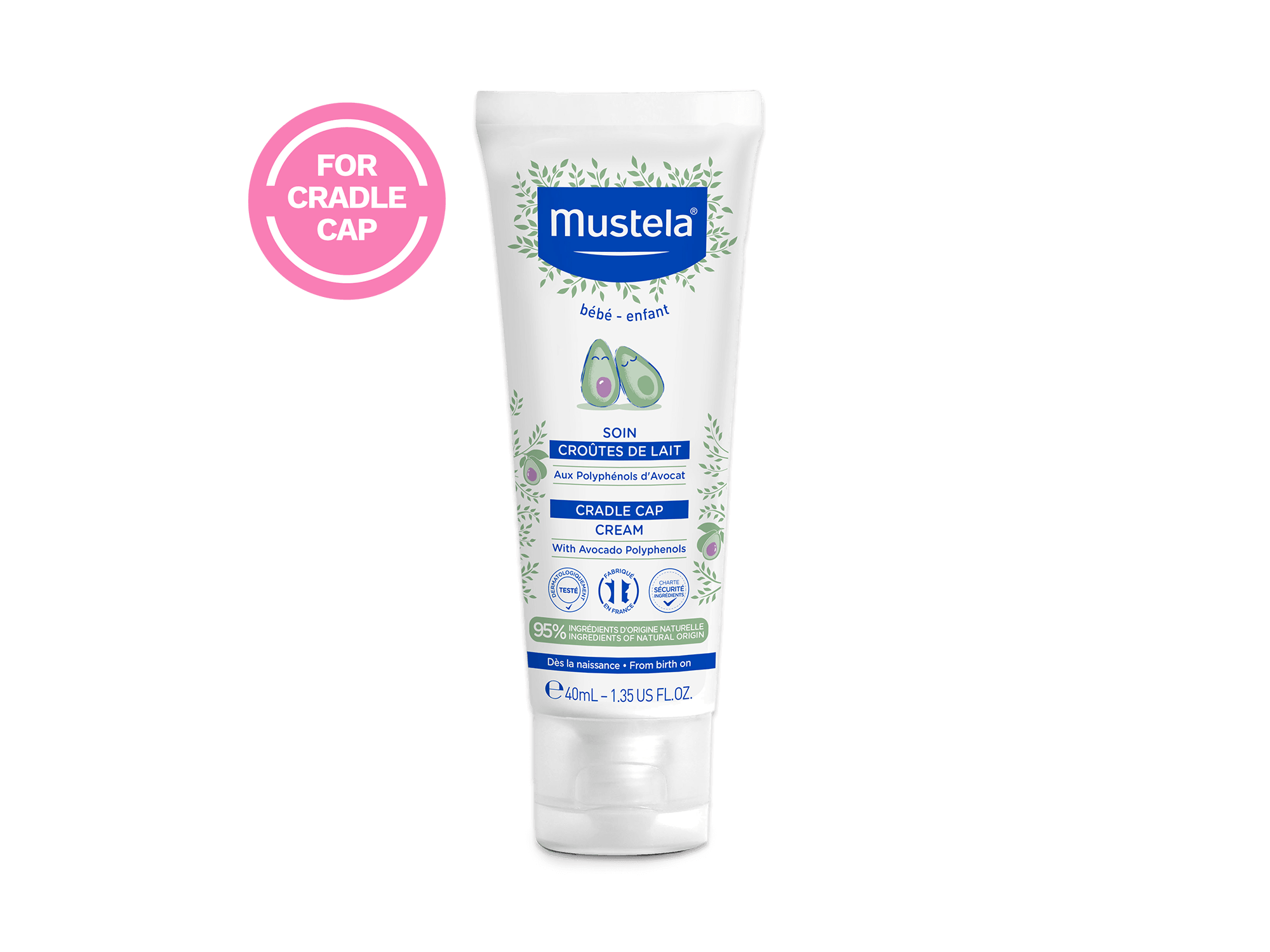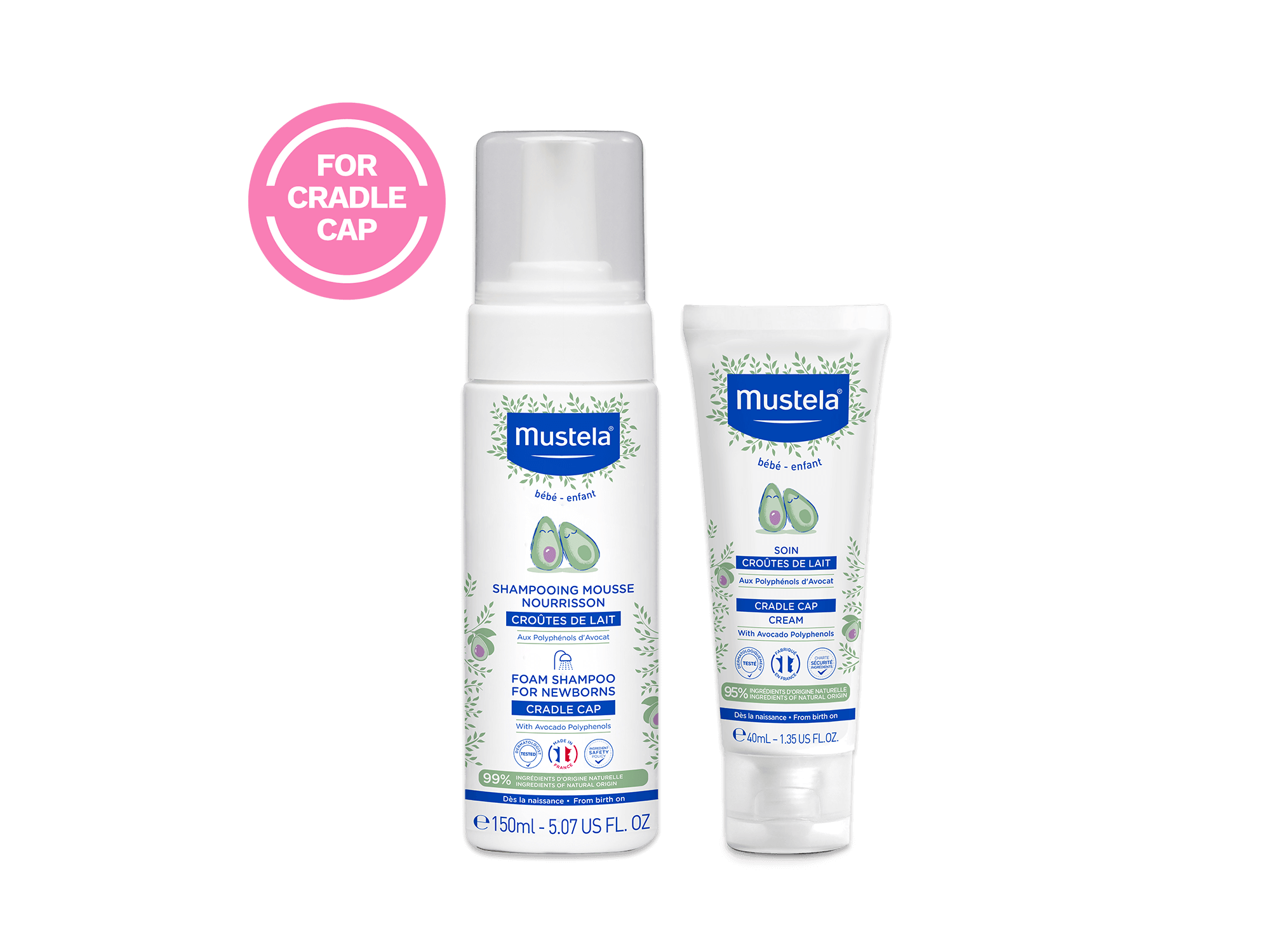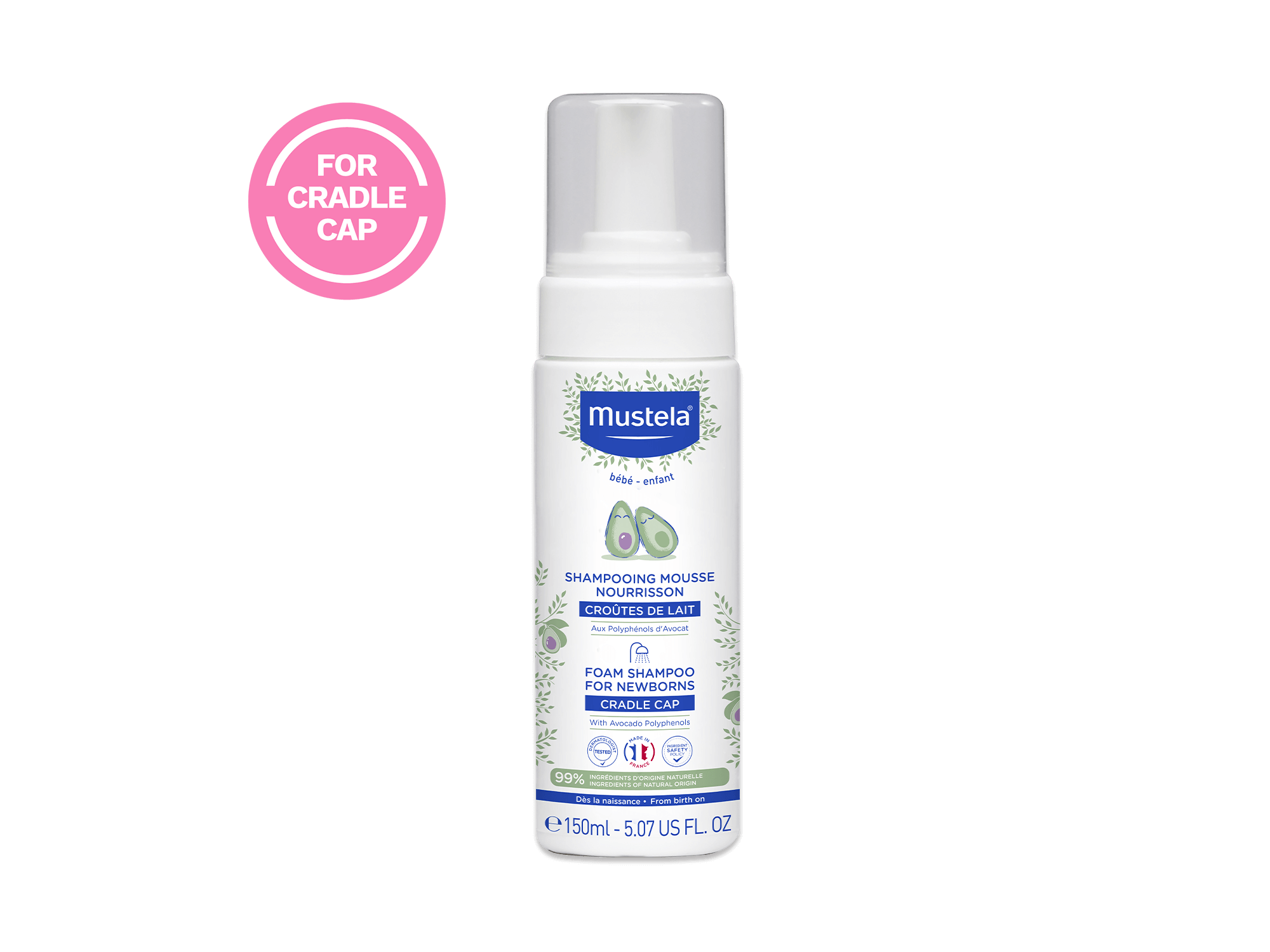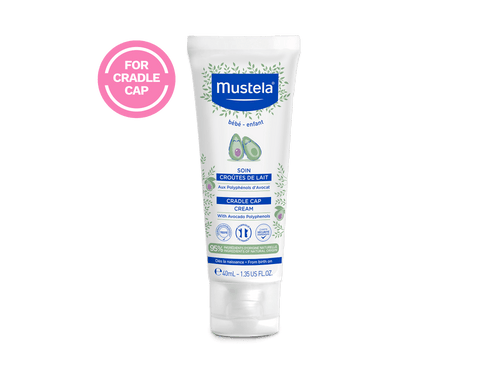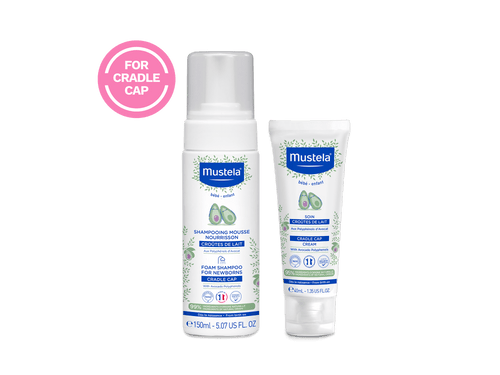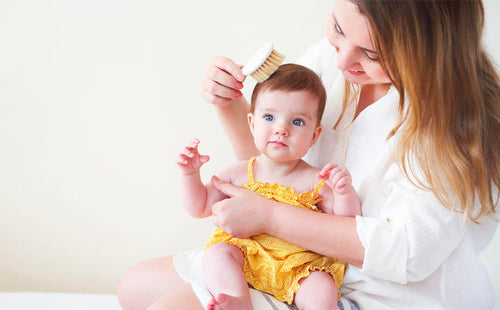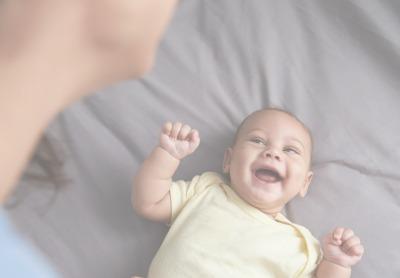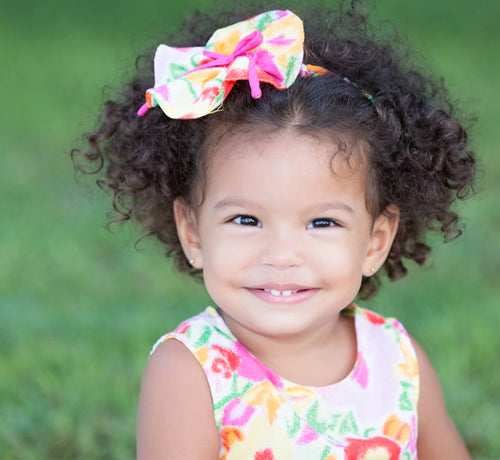Some newborns are born with a full head of hair. They might come into the world looking like punk rockers, their straight hair standing on end, or they might have thick curly hair, or look like they just went to the barber to get a buzz cut, or have no hair at all.
Newborn hair comes in every texture, color, amount, and location — from head to toe. Within a family of five children, you might see different hair on each of them at birth. The important thing to remember is that all hair variations are normal.
In this article, we’ll tell you what to expect when it comes to your newborn’s hair, how to help stimulate its growth, how to handle it, and how to care for it so your little one can have a good hair day every day.
Key Takeaways
-
Takeaway #1: Your newborn will grow hair, called lanugo, in utero. They shed this fine hair, which is on their body and face, before they are born.
-
Takeaway #2: Some babies have hair on their heads when they’re born and some don’t. They will lose their hair before they’re six months old, and they’ll grow new hair between six and 12 months of age.
-
Takeaway #3: Tips to help your newborn’s hair grow include minimizing the time they spend on their back, brushing their scalp, combing (instead of brushing) wet hair, feeding them a healthy diet, and talking to your pediatrician about using coconut oil on their head.
-
Takeaway #4: Caring for your newborn’s hair involves using gentle shampoo and warm water, gently massaging their head, avoiding tugging or pulling their hair, and more.
Newborn Hair: What To Expect

It’s impossible to know for certain what your newborn’s hair will look like. They may be born with curly hair, pin-straight locks, or no hair at all. As for color, it’s anyone’s guess.
So what can you expect when it comes to newborn hair growth? Even if the end result is a surprise, the overall timing and process remains the same, before and after your baby is born. Let’s take a look.
In Utero
Even when your baby is in your tummy, their hair is growing. In fact, your little one will get hair follicles on their scalp and body at about 14 weeks of gestation.
Then, at 16 to 20 weeks of gestation, your baby will start to get lanugo, the fine, feathery hair on their body and face. Lanugo will grow anywhere with hair follicles. Your baby’s cells will also begin making the pigment that gives their hair color.
Although the hue, texture, and curliness (or not) of your baby’s hair will most likely change, the hair follicles they are born with will remain the same for their whole life.
This hair serves several important functions: it helps the vernix (the white cheesy substance that covers the fetus) stick to the skin to protect the baby. It also regulates your baby's temperature and hormones and keeps your baby warm as they grow.
Thanks to melanin, the lanugo will get its initial color at about 23 weeks.
Your newborn will shed their lanugo by the time they are born. Losing this first hair often happens between 24 to 28 weeks of gestation, although preemies may be born with it. If your little one is born with lanugo, they’ll lose this hair after a few weeks to months on the “outside.”
At Birth

Hair is one of the most distinguishing characteristics your baby will have from birth. But don’t get too attached. That’s right: your baby’s shock of hair is in for some changes this first year!
Newborn Hair Loss And Growth
Before your newborn hits six months, most of the hair they were born with will likely be lost. You might see hair on their clothes or bed, or you might not notice it at all. Or your baby might have been born with a wild mop those first months, and then suddenly go bald.
Losing the hair they were born with is called the exogen phase. But don’t worry. Right after your little one loses the hair, new hair starts to grow. Keep in mind that this new hair, though, may look very different.
This hair loss has to do with a dip in your little one’s hormones (until now they’ve relied on your hormones). While your newborn’s hair follicles were in a growing phase when they first came into the world, now they enter a resting phase.
You may notice a change in your hair during postpartum too. It might be less shiny or break more easily. Or you may begin to lose some of your hair. This is because your hormones are shifting too. The good news? Six to twelve months after having your baby, your hair will return!
Color & Texture Changes
Once your little one’s hair starts to grow again — usually between six and 12 months — there’s no telling the color. If they were a blonde, they might become a redhead. Babies are born with the chromosomes that determine their hair color, but the shade can change until they’re five.
The texture of your baby’s hair may change too. If it was straight as an arrow, their new hair may be a mass of curls. Remember, it’s up to their particular brew of chromosomes. Genetics can combine in a million ways!

Debunking Newborn Hair Myths
Myths abound in the world of babyhood. From tales about how to determine the sex of your baby, to formulas for going into labor, to the “only way” to get your little one to sleep through the night, people have been creating fiction — forever.
Here, let’s set some of them straight. (Or curly?) At least the ones that are about your baby’s hair.
1) If You Cut Your Baby’s Hair, It Will Grow Back Thicker
Wishful thinking, but not true. Hair growth happens below the scalp, at the follicles, so no matter when or how you cut those locks, you won’t be changing the texture or amount of your baby’s hair.
2) Brushing 100 Strokes A Day Makes Your Baby’s Hair Healthier
Again, not true. In fact, brushing your baby’s hair too much can be detrimental. Overbrushing can strip hair of its natural oils, as well as cause breakage of strands of hair and damage to hair follicles.
3) A Shave of The Head Will Speed Up Hair Growth
As we said above, hair growth happens under the scalp, not on top of it. The rate of hair growth for your baby is based on genetics.
4) Washing Newborn Hair Daily Keeps It Healthy
Nope. Hair — and bodies, for that matter — do not need daily washing. Too much soap and water can cause dryness, which can then lead to hair damage.
5) Never Cut A Baby’s Hair Before Their First Birthday
Why? Supposedly because it will doom them to bad hair for the rest of their life. Age has nothing to do with when you take a pair of scissors to your baby’s hair. It’s probably better to pay attention to how they feel about it.
Does cutting their hair make them uncomfortable or are they fascinated by it? Are they able to hold their head up or are they still gaining neck strength? Will they sit still for long enough or are they wiggly?
6) Braiding Hair Stops Its Growth
This is not true either. If your baby’s hair is long enough to braid, you might want to try it and then leave the braids in for a few days. Braiding can protect hair from breaking. Don’t make them too tight though, or they’ll have the opposite effect.
Tips To Help Your Newborn’s Hair Grow
Although your newborn will grow their hair back quickly, and the specific rate at which it grows back is different for every baby, there’s no harm in helping it along. Here are a few tips to help their mane become the main event once again:
- Minimize the time your newborn spends on their back when awake.
Brush your little one’s scalp, even if they’re bald.
- Don’t brush wet hair — use a comb instead.
- Make sure your newborn eats healthily: breast milk for at least six months, and nutrient-dense foods once they’re on solids.
- Talk to your pediatrician about massaging coconut oil, an antioxidant rich in vitamin E, on your little one’s head after their bath a couple of times a week.
How To Care For Your Newborn’s Hair

Wondering what your newborn’s new coif requires? Let “keep it simple” and “less is more” be your mantras. You may have dreamed of putting your baby’s hair into all sorts of styles, but for now, it’s better to focus on the health of their hair.
Here are some pointers on how to care for your baby’s beautiful tresses.
Choose Where You’ll Wash Your Baby’s Hair
Before we get into the specifics of how to best care for your newborn’s hair, we need to take a step back and look at where you’ll wash it.
While some people prefer a small bathtub made for babies, some choose to use a mesh seat that sits in a regular tub. Using your kitchen sink is also a great option. It’s small so your baby doesn’t feel overwhelmed, and — bonus! — it’s easier on your back.
Wherever you decide to give your baby their baths, remember to use warm water. If you feel like the temperature of the water is still uncomfortable for your little one, try placing a wet washcloth over their belly. The pressure and warmth from above can be soothing.
If you choose to use the sink to wash your baby’s hair, you can also keep them wrapped in a towel and hold them close to you. This makes the hair-washing experience cozy and connected.
Don’t forget to keep the shampoo out of your baby’s eyes. They can’t help you by tipping back their head or holding their neck still, so a good idea is to hold one hand loosely over your baby’s eyes as you rinse their hair.
Use Gentle Hair Care Products
First of all, you’ll want to make sure that anything you use on your baby’s scalp is very gentle. Opt for a tear-free shampoo such as Mustela’s Foam Shampoo For Newborns.
This extra-gentle shampoo is tear-free, fragrance-free, and rinses easily. Our shampoo is made of 99% ingredients of natural origin per ISO 16128 standard including avocado polyphenols and sunflower seed oil, so you needn’t worry about an allergic reaction.
Don’t Overwash
Although you do want to keep your little one’s hair clean, you don’t want to overwash it. Washing it too often will strip your baby’s hair of its natural oils.
For many, washing their newborn’s hair two to three times a week should be sufficient. However, for black or biracial children who have textured hair, you might want to limit washing to one to two times a week and be sure to moisturize it well.
Be careful when you massage the shampoo into your baby’s scalp. Scrubbing too hard can irritate your baby’s hair follicles. And remember, when you’re washing newborn hair (or your own hair, for that matter), use lukewarm water, so you don’t dry out their skin.
Avoid Pulling Or Tugging
This is probably pretty obvious, but you don’t want to pull or tug at your newborn’s hair. Their scalp is sensitive and their hair is delicate.
Try to detangle any knots before brushing and, again, be gentle. For children with natural hair, use a wide-tooth comb or soft-bristle brush, and avoid brushing it while it’s dry.
You can also try using your fingers as a comb. Make sure your baby’s hair is wet or damp when you run them gently through their hair. One “style” benefit to using this kind of finger comb is that you can be attentive to your baby’s curl pattern and work with it.
Use A Soft Towel To Dry Baby’s Hair
Be mindful when drying your newborn’s hair, and be sure to use a soft towel and a soft touch. If the towel or your drying method is too rough, it may lead to hair breakage (and an unhappy newborn).
Skip The Accessories
It’s too soon for the high pony or barrette or clip that tugs on their hair. As we said, your newborn’s skin and hair are delicate and accessories could scratch or irritate their scalp.
Give Your Baby A Head Massage

Stimulate your little one’s hair growth by giving them a head massage. Just cradle their head in your hands and gently massage their scalp with the tips of your fingers. Not only will it help their hair to grow, but it will also release tension, improve blood flow, and even help them sleep.
One note, massage time is not an invite to a shelf of new products. As we said in the beginning, less is more.
Try Some Tummy Time
Your newborn probably spends a lot of time on their back, which can result in friction and hair loss.
Flipping them over onto their tummy will not only help them keep their mane in place (as there is no inadvertent pulling or tugging), but it will also help them strengthen their neck muscles, develop motor skills, and avoid flat head syndrome.
Tummy time also promotes sensory development and bonding. That’s a whole lot of good things!
Treat Cradle Cap Early
Get ahead of cradle cap by treating your little one’s scalp as soon as you notice any scales. As cradle cap may have some relationship with hair loss, treating it sooner may pay off in the long run.
Our Cradle Cap Duo features both a delicate foam baby shampoo and a leave-on treatment to clean the hair and scalp while soothing your baby’s skin barrier. The tear-free, fragrance-free formula uses 99% ingredients of natural origin per ISO 16128 standard that are both safe and effective for the condition.
Hold Off On Cutting Your Baby’s Hair
Another hair care tip for your newborn is to resist the urge to go to the hairdresser too soon. Although some say an early cut will make a baby’s hair thicker and grow better, there’s no evidence that’s true.
It’s best to wait until your baby can properly sit up in the chair, which means at least six months when they develop head and neck control.
Go to a professional who’s used to cutting children’s hair, and then when it’s all done, snap a pic of your baby’s latest milestone and keep a lock for their baby book.
Love Your Little One’s Locks

Now you have a better idea of what to expect and how to care for your baby’s lovely locks (or lack thereof). You know not to panic when they inevitably lose their hair and can enjoy the surprise of how their newborn hair grows back.
To keep your baby’s hair and scalp healthy, Mustela is here to help. Our Gentle Shampoo is tear-free, and will not strip the natural oils from baby’s hair.
Let Mustela help your little one have a good hair day from day one!
Frequently Asked Questions:
Do babies get their hair from their mother or father?
While scientists don’t know the exact number of genes needed from a baby’s mother and father to determine hair color and texture, they do know that multiple gene pairs (one from each parent) predict the characteristics of hair.
The color of a baby’s parents’ hair doesn’t always determine their hair color. Two parents with dark brown hair could have a baby with red hair, for example. This would mean both mother and father carry the recessive gene that makes hair red.
Can breast milk soothe cradle cap?
Yes, it actually can! Breast milk contains natural antibacterial properties that can help your baby’s irritated scalp. You just put a little bit on the cradle cap-affected area and gently rub it in. Let it sit for a few minutes and then use a washcloth to massage your baby’s scalp.
This should help loosen the scales. After that, rinse off the breast milk and shampoo your baby’s hair however you usually do. You can do this as many times as you want to try to improve the cradle cap.
Can you use a hair dryer on a newborn’s hair?
If you want to speed up your baby’s hair-drying process, you can use a hair dryer, but you need to do it carefully. Keep the dryer about 12 inches from your baby’s head and make sure you put it on its cool setting. (Test it on yourself first.)
Use a brush, comb, or better yet, your fingers to comb your baby’s hair to prevent tangles while you’re drying it. Other ways to speed up the hair-drying process include rubbing a soft towel gently on your baby’s hair or, if they have fine hair, brushing it a few times might do the trick.

